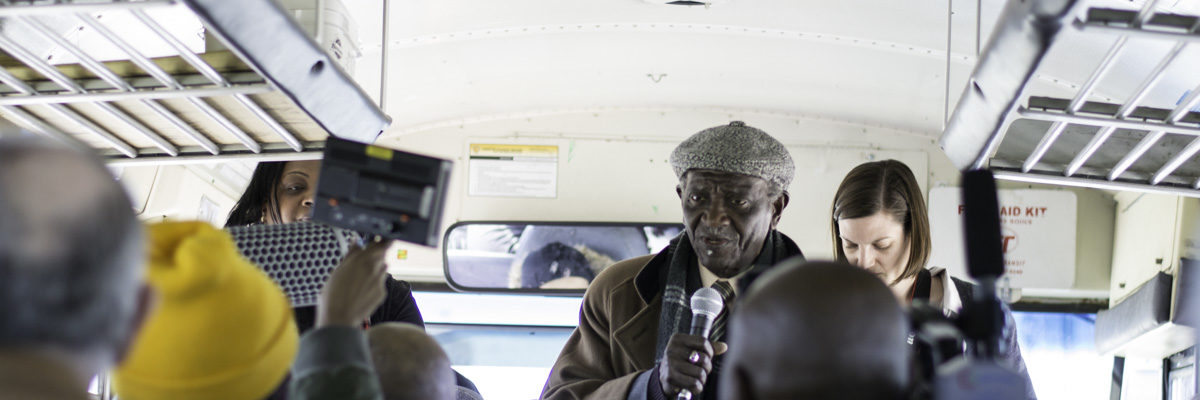It was a beautiful, cold, sunny day – perfect to imagine yourself as a future rider of the Finch West Light Rail Transit (LRT). Construction on the planned Toronto rapid transit line will kick off later this year. But how can we ensure that such massive transit projects generate the best possible outcomes for local communities? To find out, we joined the Toronto Community Benefits Network on a bus tour with local community leaders.
This unique visit to the area kicked off the network’s Creating Opportunities Summit. Three school buses full of eager learners and seasoned local community leaders travelled the planned LRT route between the snazzy new zebra-striped Finch West subway station and the North Campus of Humber College.
Along the way, we heard from community residents and leaders such as Winston LaRose – known to many as “Mr. Jane and Finch” – a community activist in the area for over 50 years. The line will pass through seven of Toronto’s Neighbourhood Improvement Areas where residents face challenges related to local economic opportunities, social development, participation in in decision-making, and physical surroundings.
The new line is generating excitement and activity in the area: “Make your investments in Jane and Finch now before it is too late!” advised LaRose. However, there are also serious discussions underway about how this complex and massive $1.2 billion project will impact the local area – for better or for worse. Construction cranes have already arrived to drive development in anticipation of the impending LRT project. In response, groups such as Toronto Community Benefits Network, Community Action Planning Group, Community Organizing for Responsible Development, Rexdale Rising, and Grow Our Grassways are building momentum in their communities. Their goal: leverage the LRT investment into an enduring legacy for local neighbourhoods.
As the bus passed the Jane and Finch intersection, we heard about community hopes to redevelop this area as the neighbourhood’s new “downtown” core with updated shopping facilities and new residences. A little further west we stopped at a large vacant site slated for a Metrolinx light rail maintenance and storage facility. The facility would have occupied a huge area of the streetscape, so residents asked to develop new community amenities in the front end of the site. Members of the Community Action Planning Group told us that through their interventions, Metrolinx included a 32 metre-setback in the project’s requests for proposals. A great win for the community!
A little further down the line, we got off the bus and piled into the Metrolinx community offices. There we heard about the proposed Community Benefits Agreement for the Finch West LRT project. Led by the Toronto Community Benefits Network and modelled on a similar agreement now in place for the Eglinton Crosstown Line, the agreement seeks to drive local employment – both in the trades and in professional and administrative areas. “It’s a good start,” said Toronto Community Benefits Network Executive Director Rosemarie Powell, “but we can do more.”
Passing through Rexdale, we heard about residents’ strong interest in ensuring that the new private Woodbine Racetrack development will provide a net benefit to the local community. To offset the social burdens that community members fear access to a gambling facility will bring, they want guarantees for local amenities and jobs that pay a living wage. We also heard first-hand about the personal challenges experienced by social housing residents who are re-located to facilitate housing re-development – more of which is expected in future.
I stepped off the bus at the end of the tour feeling inspired by the calibre of local leadership. I’m much better educated now about the challenges local communities along the Finch West LRT face, but many questions remain.
Do cranes in the Jane and Finch and adjacent neighbourhoods foreshadow gentrification of the area? Could this development ultimately price current residents out of their homes and communities? Will the Community Benefits Agreement negotiated with Metrolinx endure through the inevitable bumps and grinds of its multi-year implementation, especially when the agreement is not legally binding? Will Mr. Jane and Finch see his long-held vision realized in the form of a new enlivened core in the area? Will the community attract the funding needed to build a welcoming streetscape in front of the light rail maintenance yard?
We really appreciated the chance to learn from those who are deeply involved in deriving community benefits from public transit investment in their communities. I’m certain we will see strong and savvy neighbourhood leadership on the Finch West LRT file.
Helping local communities benefit from investments in low-carbon infrastructure helps us achieve the co-benefits envisioned in the TransformTO climate plan. And Community Benefits Agreements are one tool that could unlock the multiple benefits associated with a wide range of climate actions. For example, how can we leverage public funding for energy retrofits in buildings to achieve co-benefits such as local job creation and improved resident comfort? Finding ways to combine climate action with other important community objectives a will be a key area of TAF’s activities in support of TransformTO this year, so stay tuned for more exploration on this front – or share your ideas by posting a comment below.

